Scottish household survey 2017: annual report
Results from the 2017 edition of the continuous survey based on a sample of the general population in private residences in Scotland.
12 Culture and Heritage
Main Findings
There are high and increasing levels of cultural engagement in Scotland. Around nine in ten (93 per cent) adults were culturally engaged in 2017, either by attending or visiting a cultural event or place or by participating in a cultural activity. The level of cultural engagement has increased by around six percentage points since first recorded in 2007.
Cultural attendance
Around eight in ten adults in Scotland had recently attended a cultural event or place of culture in 2017. The level of cultural attendance has increased by 10 percentage points since 2012.
Women, younger people, those with degrees or professional qualifications, those with good physical and mental health and those living in less deprived areas are more likely to attend cultural events. This profile has remained the same over time.
Cultural participation
Overall participation in cultural activities is high (78 per cent), and has remained largely unchanged since 2012. The most popular form of cultural participation was reading for pleasure.
Overall participation in cultural activities was higher among women, those with degrees or professional qualifications, those with good physical and mental health and those living in less deprived areas.
The overall level of cultural participation doesn’t change with age. However, the types of cultural activities people participate in changes with age for most activities. This picture of cultural participation has not changed over time.
Cultural services provided by local authorities
Satisfaction with local authority services provision in 2017 has increased from 2007. Library services satisfaction declined during this period.
In 2017, around nine in ten adults who had used local authority cultural services were very or fairly satisfied with their provision.
12.1 Introduction and Context
Culture, creativity and a rich, diverse heritage sit at the heart of life in Scotland and play a critical role in the economy, communities and almost everything we do. The Scottish Government is committed to supporting, developing and advocating Scotland's culture, heritage and creativity, and ensuring that culture reaches a wide audience at home and abroad. The Scottish Household Survey is the primary source of data on heritage and cultural engagement Scotland.
The Scottish Government is currently developing a Culture Strategy for Scotland, in close consultation with partners and the general public. A public consultation was held in summer 2018 and the finalised strategy is due to be published later in 2018.
The strategy seeks to stimulate a step change that will bring about a shift in how society and government view and value culture. It is centred on the fundamental value of culture and its empowering and transformative potential for the whole of society.
The aims of the strategy are to:
- recognise that culture and creativity are central to Scotland’s cultural, social and economic prosperity;
- open up and extend culture so that it is of and for every community and everyone;
- sustain and nurture culture to flourish and to evolve as a diverse, positive force in society, across all of Scotland.
A key development that will help to achieve these ambitions is the inclusion of a new national outcome for culture in the newly refreshed National Performance Framework[75]. This is an important development that signifies that Scottish Ministers and the Scottish Government recognise the potential and importance of culture as an intrinsic part of Scotland’s wellbeing and that other policy areas should give consideration to it. The national outcome is:
“We are creative and our vibrant and diverse cultures are expressed and enjoyed widely”
Four new national indicators will monitor progress against this outcome. These are:
- Attendance at cultural events or places of culture
- Participation in a cultural activity
- Growth in the cultural economy
- People working in arts and culture
The first two national indicators are measured using the data from the SHS at national and sub national levels on attendance and participation in cultural activities that is presented in this chapter.
This data helps the Scottish Government and our key partners across the public sector and cultural sectors to monitor the progress of culture strategy ambitions which in turn will inform strategic policy decisions.
Cultural engagement is defined as those adults who have either participated in a cultural activity or who have attended at least one type of cultural event or place in the past 12 months. The SHS is the only source of data on attendance and participation at local authority level. Questions on cultural attendance were introduced in the SHS for the first time in 2007. From 2012 onwards, it is possible to obtain data at local authority level every year. For 2017, these data will be published at a later date.
Attendance at "a cultural event or place of culture" is defined as those adults who attended at least one type of cultural place in the previous year. There are a number of different types of cultural events and places of culture: cinemas, museums, libraries and live music events, for example. Likewise, participation in any cultural activity means that adults take part in at least one activity in the previous year. Examples of cultural activities include reading for pleasure, dancing and crafts.
The Glossary in Annex 2: Glossary provides a full list of activities, places or events for cultural attendance and participation.
Please note that figures from 2012 onwards are not directly comparable with previous years, due to a change of wording in 2012. More detail about the culture questions can be found in the historical SHS questionnaires[76].
12.2 Cultural Engagement
Figure 12.1 shows that around nine in ten adults had attended or participated in some cultural event or activity in 2017 (93 per cent). Trips to the cinema make up the majority of cultural attendance, and reading for pleasure is the most common participation activity. The level of cultural engagement in Scotland has increased by around 6 percentage points since it was first recorded in the SHS in 2007.
Cultural engagement is a composite measure of both cultural attendance and participation. Each of these will be reported on separately in the sections to follow.
Figure 12.1: Cultural engagement by adults in the last 12 months by year
Percentages, 2007 to 2017 data (minimum base: 9,130)
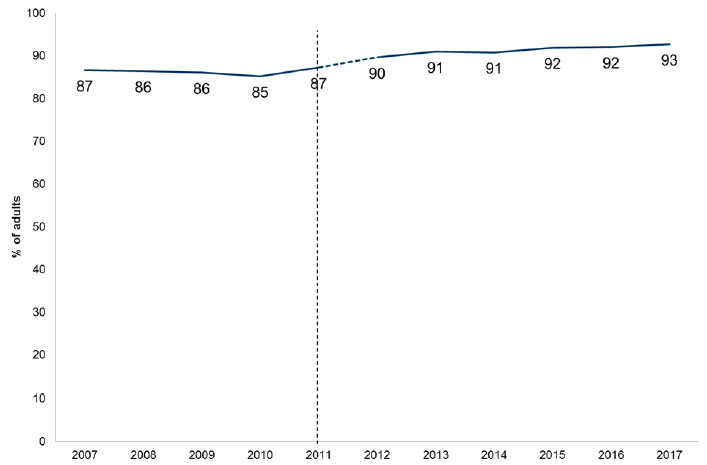
* Note that the figures for from 2012 onwards are not directly comparable with previous years due to changes in the wording of the cultural attendance and participation questions.
12.3 Attendance at Cultural Events and Places
Figure 12.2 shows how attendance has changed since 2012. In 2017, around eight in ten adults had attended a cultural event or place of culture in the last 12 months (84 per cent). When trips to the cinema are excluded, the attendance figure was lower at 77 per cent. Since 2012, attendance when cinema trips are included has increased from 78 per cent to 84 per cent. When trips to the cinema are excluded, the attendance figure has increased from 70 per cent to 77 per cent.
Attendance has increased for almost all of the individual cultural events or places since 2012. The biggest increases from 2012 were in the number of adults who visited historical or archaeological places which increased by 8 percentage points (28 to 35 per cent). Similarly, the number of people who attended street art events has increased by 6 percentage points between 2012 and 2017 (12 per cent to 18 per cent). Attendance at libraries and book festivals or reading groups has remained static over this period.
Figure 12.2: Attendance at cultural events and visiting places of culture in the last 12 months
Percentage of adults, 2012 to 2017 data (minimum base: 9,410)
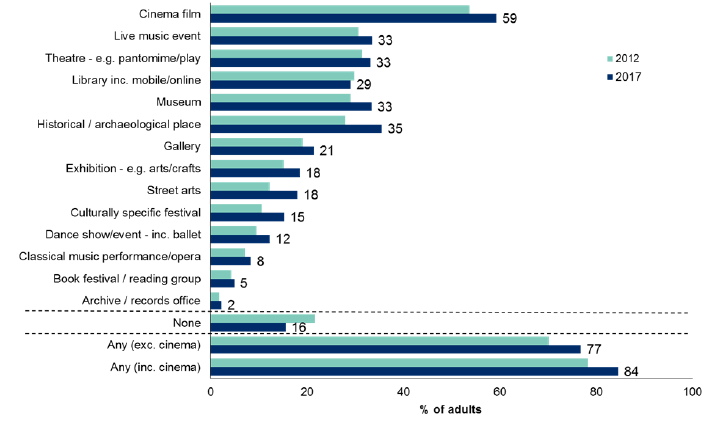
12.3.1 Attendance by Gender and Age
Table 12.1 shows that in 2017, more women attended a cultural event than men (86 per cent and 83 per cent). Women also had higher cultural attendance than men after excluding trips to the cinema, with the gap between men and women increasing to 5 percentage points (79 per cent and 74 per cent).
More women than men attended the theatre (38 per cent, compared with 28 per cent). Women were also more likely than men to visit the library (32 per cent compared with 26 per cent).
Table 12.1 shows that in 2017, the younger age groups were more likely to attend a cultural event than the older age groups. Ninety four per cent of 16 to 24 year olds attended a cultural event compared to 63 per cent of those aged 75 and over. Sixteen to 24 year olds also had higher cultural attendance than those aged 75 and over after excluding trips to the cinema (80 per cent and 61 per cent).
People in the younger age groups were more likely to have attended the cinema. Eighty-five per cent of adults aged 16 to 24 and 75 per cent of 25-34 year olds visited the cinema, compared with 19 per cent of those aged 75 or over. Similarly, almost half of 16 to 24 year olds (43 per cent) attended a live music event, compared with 10 per cent of those aged 75 or over.
Table 12.1: Attendance at cultural events and visiting places of culture in the last 12 months by gender and age
Percentages, 2017 data
| Adults | Male | Female | 16 to 24 | 25 to 34 | 35 to 44 | 45 to 59 | 60 to 74 | 75 plus | All |
|---|---|---|---|---|---|---|---|---|---|
| Cinema | 58 | 60 | 85 | 75 | 72 | 60 | 39 | 19 | 59 |
| Live music event - e.g. traditional music, rock concert, jazz event (not opera or classical music performance) | 34 | 33 | 43 | 41 | 39 | 38 | 23 | 10 | 33 |
| Theatre - e.g. pantomime / musical / play | 28 | 38 | 25 | 29 | 35 | 38 | 38 | 27 | 33 |
| Library (including mobile and online) | 26 | 32 | 32 | 29 | 40 | 24 | 27 | 26 | 29 |
| Museum | 33 | 33 | 32 | 39 | 42 | 33 | 30 | 19 | 33 |
| Historic place - e.g. castle, stately home and grounds, battle or archaeological site | 37 | 34 | 32 | 40 | 46 | 38 | 32 | 18 | 35 |
| Gallery | 21 | 22 | 22 | 22 | 25 | 23 | 21 | 11 | 21 |
| Exhibition - including art, photography and crafts | 18 | 19 | 18 | 18 | 22 | 20 | 19 | 10 | 18 |
| Street arts (e.g. musical performances or art in parks, streets or shopping centre) | 18 | 18 | 21 | 22 | 24 | 19 | 13 | 4 | 18 |
| Culturally specific festival (e.g. mela /Feis/ local Gala days) |
15 | 15 | 15 | 15 | 24 | 17 | 12 | 6 | 15 |
| Dance show / event - e.g. ballet | 10 | 14 | 10 | 12 | 16 | 14 | 12 | 4 | 12 |
| Classical music performance or opera | 8 | 9 | 8 | 6 | 8 | 8 | 11 | 9 | 8 |
| Book festival or reading group | 4 | 6 | 4 | 5 | 6 | 4 | 6 | 4 | 5 |
| Archive or records office (e.g. Scotland's Family History Peoples Centre) | 2 | 2 | 1 | 2 | 2 | 3 | 3 | 2 | 2 |
| None | 17 | 14 | 6 | 9 | 8 | 15 | 23 | 37 | 16 |
| Any cultural attendance (excluding cinema) | 74 | 79 | 80 | 81 | 83 | 78 | 73 | 61 | 77 |
| Any cultural attendance (including cinema) | 83 | 86 | 94 | 91 | 92 | 85 | 77 | 63 | 84 |
| Base | 4,540 | 5,270 | 650 | 1,290 | 1,400 | 2,410 | 2,590 | 1,480 | 9,810 |
Columns may not add to 100 per cent since multiple responses were allowed.
12.3.2 Attendance by Highest Level of Qualification
Figure 12.3 shows that in 2017, adults with degrees or professional qualifications were most likely to attend cultural places and events; whereas attendance was lowest for those with no qualifications (96 per cent compared to 58 per cent). The pattern holds when cinema attendance is excluded (91 per cent compared to 52 per cent).
Figure 12.3: Attendance at cultural events and visiting places of culture in the last 12 months by highest level of qualification
2017 data, percentage of adults (minimum base: 480)
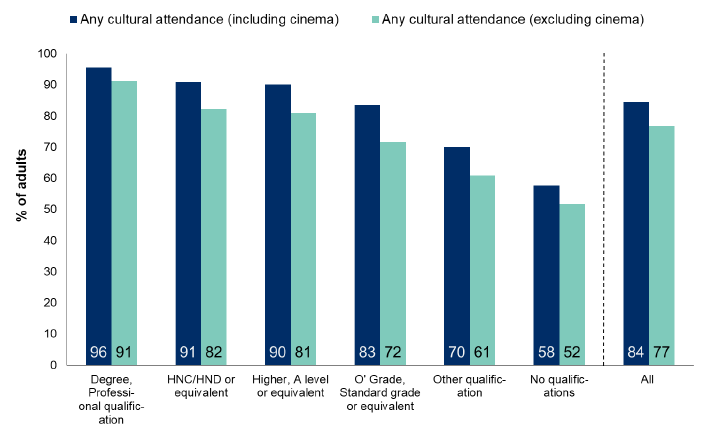
Table 12.2 gives a breakdown of attendance at each individual cultural event or place. As with the overall figure, attendance was consistently higher for adults with a degree or professional qualification at individual events or places. The most marked differences between those with degrees and no qualifications can be seen for attendance at the cinema (75 per cent and 25 per cent respectively) and at a historic place (55 per cent and 12 per cent respectively).
Table 12.2: Attendance at cultural events and visiting places of culture in the last 12 months by highest qualification level
Percentages, 2017 data
| Adults | Degree, Professional qualification | HNC/HND or equivalent | Higher, A level or equivalent | O' Grade, Standard grade or equivalent | Other qualification | No qualifications | All |
|---|---|---|---|---|---|---|---|
| Cinema | 75 | 69 | 69 | 56 | 28 | 25 | 59 |
| Live music event - e.g. traditional music, rock concert, jazz event (not opera or classical music performance) | 47 | 40 | 37 | 27 | 11 | 13 | 33 |
| Theatre - e.g. pantomime / musical / play | 46 | 34 | 33 | 27 | 30 | 17 | 33 |
| Library (including mobile and online) | 40 | 29 | 32 | 21 | 19 | 18 | 29 |
| Museum | 52 | 36 | 33 | 24 | 19 | 13 | 33 |
| Historic place - e.g. castle, stately home and grounds, battle or archaeological site | 55 | 41 | 35 | 25 | 17 | 12 | 35 |
| Gallery | 36 | 24 | 20 | 13 | 9 | 7 | 21 |
| Exhibition - including art, photography and crafts | 34 | 21 | 17 | 10 | 5 | 3 | 18 |
| Street arts (e.g. musical performances or art in parks, streets or shopping centre) | 28 | 22 | 17 | 13 | 7 | 4 | 18 |
| Culturally specific festival (e.g. mela /Feis/ local Gala days) |
24 | 16 | 15 | 11 | 5 | 5 | 15 |
| Dance show / event - e.g. ballet | 18 | 12 | 12 | 10 | 3 | 6 | 12 |
| Classical music performance or opera | 17 | 6 | 6 | 4 | 5 | 2 | 8 |
| Book festival or reading group | 10 | 4 | 5 | 2 | 2 | 1 | 5 |
| Archive or records office (e.g. Scotland's Family History Peoples Centre) | 4 | 2 | 2 | 2 | 1 | 1 | 2 |
| None | 4 | 9 | 10 | 17 | 30 | 42 | 16 |
| Any cultural attendance (excluding cinema) | 91 | 82 | 81 | 72 | 61 | 52 | 77 |
| Any cultural attendance (including cinema) | 96 | 91 | 90 | 83 | 70 | 58 | 84 |
| Base | 2,880 | 1,080 | 1,510 | 1,770 | 480 | 1,990 | 9,810 |
Columns add to more than 100 per cent since multiple responses allowed.
12.3.3 Attendance by Scottish Index of Multiple Deprivation (SIMD)
Figure 12.4 shows that levels of cultural attendance increase as deprivation as measured by the Scottish Index of Multiple Deprivation (SIMD 2016) decreases.
In 2017 there was a 16 percentage point difference in cultural attendance (including cinema) between the 20 per cent most and 20 per cent least deprived areas (77 per cent compared with 93 per cent). This gap has narrowed since 2014 when the gap was 20 percentage points. When cinema attendance is excluded, the difference is even greater, with 65 per cent in the most deprived areas and 88 per cent in the least deprived areas.
Figure 12.4: Attendance at cultural events and visiting places of culture in the last 12 months by Scottish Index of Multiple Deprivation
2017 data, Adults (minimum base: 1,810)
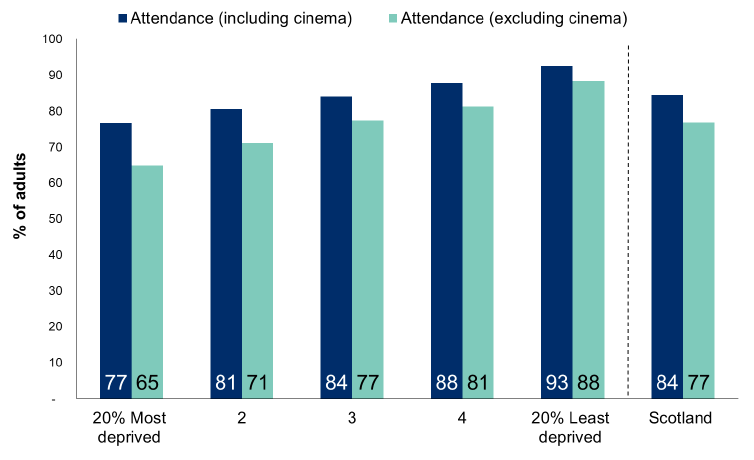
Figure 12.5 shows the difference in attendance at cultural events between the 20 per cent most and least deprived areas and how this has changed over time. This shows that this gap has narrowed since 2012 when cinema attendance is included.
Figure 12.5: Attendance at cultural events and visiting places of culture by area deprivation
2012 - 2017 data, Adults (minimum base: 1,640)
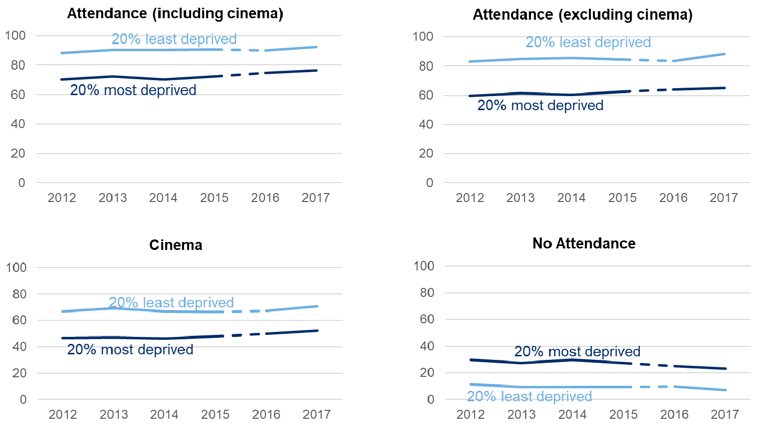
12.3.4 Attendance by Long-Term Physical/Mental Health Condition
Figure 12.6 shows that cultural attendance was lowest among adults with a physical or mental health condition that caused long term major reduced daily capacity (60 per cent compared to 89 per cent attendance for those with no condition). For those whose condition caused minor reduced daily capacity, the attendance rate was 78 per cent.
Figure 12.6: Attendance at cultural events and visiting places of culture in the last 12 months by long term physical/mental health condition
2017 data, adults (minimum base: 1,270)
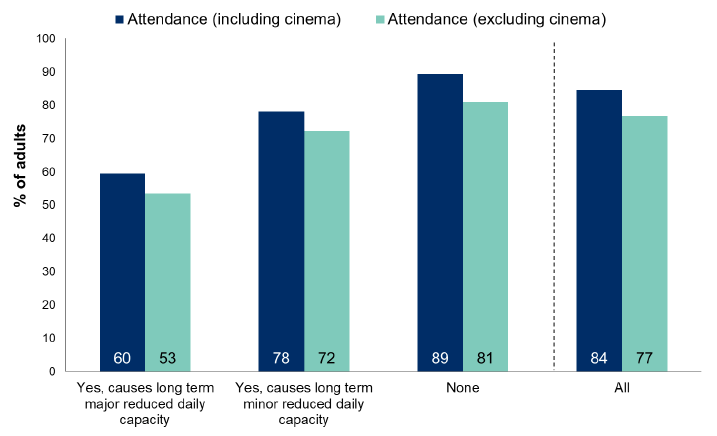
12.3.5 Frequency of Attending cultural events or places
The library was the most frequently attended cultural place or event, with one in five people (20 per cent) attending at least once a week, and almost double that number attending at least once a month (36 per cent).
Cinema attendance was the next most popular, with 19 per cent of respondents attending at least once a month. Table 12.3 shows the frequency of cultural attendance in the past year.
Table 12.3: Frequency of attending cultural events and visiting places of culture in the last 12 months
Percentages, 2017 data
| Adults | At least once a week | Less often than once a week / at least once a month | Less often than once a month but within the last 12 months | Don't know | Total | Base |
|---|---|---|---|---|---|---|
| Cinema | 2 | 19 | 78 | 0 | 100 | 5,030 |
| Live music event - e.g. traditional music, rock concert, jazz event (not opera or classical music performance) | 1 | 10 | 88 | 0 | 100 | 2,910 |
| Theatre - e.g. pantomime / musical / play | 1 | 5 | 94 | 0 | 100 | 3,120 |
| Library (including mobile and online) | 20 | 36 | 43 | 1 | 100 | 2,810 |
| Museum | 1 | 10 | 89 | 0 | 100 | 3,090 |
| Historic place - e.g. castle, stately home and grounds, battle or archaeological site | 1 | 10 | 88 | 0 | 100 | 3,210 |
| Gallery | 2 | 11 | 87 | 0 | 100 | 1,980 |
| Exhibition - including art, photography and crafts | 1 | 7 | 91 | 1 | 100 | 1,770 |
| Street arts (e.g. musical performances or art in parks, streets or shopping centre) | 1 | 6 | 92 | 1 | 100 | 1,540 |
| Culturally specific festival (e.g. mela /Feis/ local Gala days) | 1 | 2 | 96 | 1 | 100 | 1,410 |
| Dance show / event - e.g. ballet | 1 | 3 | 96 | 0 | 100 | 1,090 |
| Classical music performance or opera | 1 | 8 | 90 | 1 | 100 | 840 |
| Book festival or reading group | 2 | 11 | 84 | 3 | 100 | 470 |
| Archive or records office (e.g. Scotland's Family History Peoples Centre) | 2 | 7 | 83 | 8 | 100 | 240 |
Columns add to more than 100 per cent since multiple responses allowed.
12.3.6 Reasons for non-attendance
Those who reported not attending any cultural place or event in 2017 were asked
about potential reasons for non-attendance. In 2017, the most common reason for not attending cultural events or places was ‘not really interested’. Forty-one per cent of non-attenders stated this as a reason for not attending, an increase of seven percentage points from 2013 (34 per cent). The next most common reasons were ‘health isn’t good enough’ (at just under a third, 29 per cent), followed by ‘It’s difficult to find the time’ (14 per cent), and ‘it costs too much’ (nine per cent) (Figure 12.7).
Figure 12.7: Reasons for non-attendance at cultural events/places in the last 12 months, 2013 and 2017
Percentage of adults, 2013 and 2017 data (minimum base: 1,910)
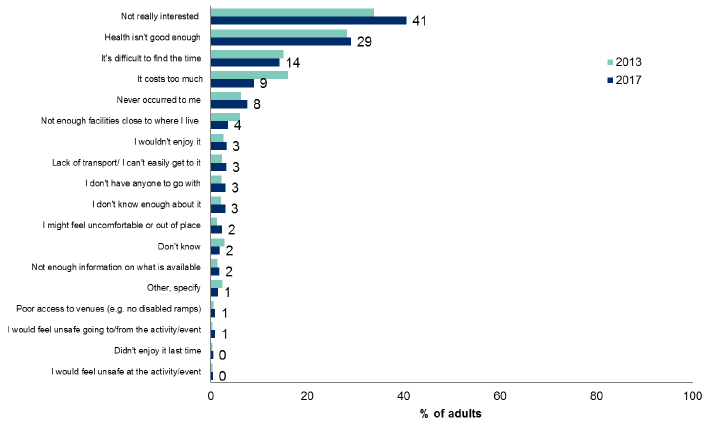
The reasons for non-attendance varied by age. Cost as a reason for non-attendance was significantly higher among those non-attenders in younger age groups, ranging from 26 per cent of those aged 16 to 24 to two per cent for those aged 75 and older. Poor health as a reason for non-attendance showed an opposite pattern, where younger age groups were significantly less likely to cite this reason than older age groups (12 per cent compared to 50 per cent respectively).
12.4 Participation in Cultural Activities
Figure 12.8 shows levels of participation by adults at specific cultural activities in the last 12 months in 2012 and 2017. Overall participation in 2017 was 78 per cent, which has remained unchanged since 2012. When reading is excluded, participation was 54 per cent. This has increased from 48 per cent in 2012.
Reading for pleasure was by far the most common cultural activity in 2017, with 65 per cent of respondents saying that they had done this in the last year.
The next most popular activity was doing creative work on a computer or by social media (27 per cent), followed by crafts (17 per cent). Participation levels in all other cultural activities was 12 per cent or less.
About one in five people (22 per cent) had not participated in any cultural activity in the last 12 months.
Figure 12.8: Participation in cultural activities in the last 12 months
Percentage of adults (minimum base: 9,410)
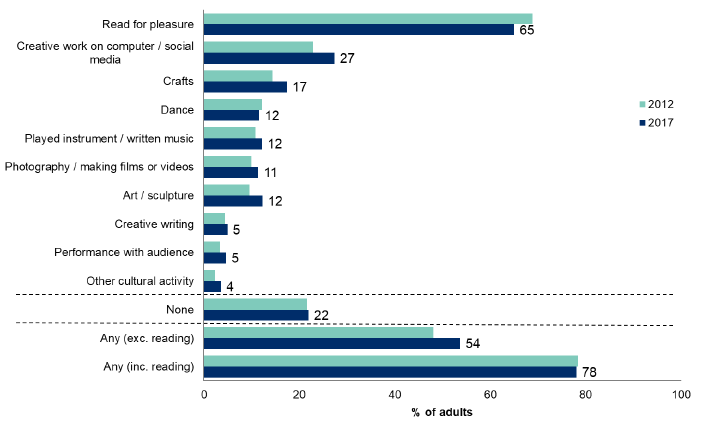
12.4.1 Participation by Gender and Age
Table 12.4 shows that in 2017, more women than men participated in a cultural activity in the last 12 months (83 per cent and 73 per cent respectively), although this did vary by activity. When reading is excluded, the difference between women and men was slightly smaller (seven percentage points).
Women participated more than men in a number of cultural activities including reading for pleasure (71 per cent compared with 58 per cent), crafts (26 per cent compared with eight per cent) and dance (14 per cent compared with 9 per cent). Men had higher participation rates than women for playing a musical instrument or writing music (15 per cent of men and nine per cent of women) and using a computer or social media to produce creative work (29 per cent compared with 26 per cent).
Overall cultural participation was broadly similar for all age groups; however, participation decreased with age when reading was excluded from the measure.
For most cultural activities, younger adults, particularly those aged 16-24 were more likely than older age groups to participate in cultural activities. However, older people were more likely to read for pleasure and do craftwork such as knitting, woodwork and pottery.
Table 12.4: Participation in any cultural activity in the last 12 months by gender and age
Column percentages, 2017 data
| Adults | Male | Female | 16 to 24 | 25 to 34 | 35 to 44 | 45 to 59 | 60 to 74 | 75 plus | All |
|---|---|---|---|---|---|---|---|---|---|
| Read for pleasure (not newspapers, magazines or comics) | 58 | 71 | 56 | 58 | 68 | 68 | 70 | 65 | 65 |
| Used a computer / social media to produce creative work of any kind | 29 | 26 | 40 | 33 | 32 | 27 | 21 | 9 | 27 |
| Crafts such as knitting, wood, pottery, etc. | 8 | 26 | 11 | 16 | 16 | 18 | 22 | 18 | 17 |
| Dance - e.g. ceilidh, salsa, Highland dancing, ballet | 9 | 14 | 15 | 15 | 11 | 11 | 11 | 5 | 12 |
| Played a musical instrument or written music | 15 | 9 | 21 | 14 | 13 | 11 | 9 | 5 | 12 |
| Photography / making films or videos as an artistic activity (not family or holiday 'snaps') | 13 | 10 | 14 | 12 | 13 | 12 | 10 | 5 | 11 |
| Painting, drawing, printmaking or sculpture | 9 | 16 | 21 | 16 | 16 | 9 | 9 | 4 | 12 |
| Creative writing - stories, books, plays or poetry | 5 | 5 | 8 | 6 | 6 | 4 | 4 | 3 | 5 |
| Took part in a play / sang in a choir or other performance (not karaoke) | 4 | 5 | 8 | 3 | 4 | 4 | 5 | 3 | 5 |
| Other cultural activity | 4 | 3 | 4 | 5 | 5 | 3 | 3 | 3 | 4 |
| None | 27 | 17 | 25 | 25 | 18 | 20 | 21 | 26 | 22 |
| Participated in any (excluding reading) | 50 | 57 | 61 | 57 | 57 | 53 | 51 | 39 | 54 |
| Participated in any (including reading) | 73 | 83 | 75 | 75 | 82 | 80 | 79 | 74 | 78 |
| Base | 4,540 | 5,270 | 650 | 1,290 | 1,400 | 2,410 | 2,590 | 1,480 | 9,810 |
Columns add to more than 100 per cent since multiple responses allowed.
12.4.2 Participation by Highest Level of Qualification
As with cultural attendance, Figure 12.9 shows that participation in cultural activities in 2017 was highest among adults with a degree or professional qualification (92 per cent) and lowest for those with no qualifications (59 per cent). When reading is excluded, the difference between qualification levels is even greater (70 per cent for those with a degree or professional qualifications, compared with 31 per cent for those with no qualifications).
Figure 12.9: Participation in any cultural activity in the last 12 months by highest level of qualification
2017 data, percentage of adults (minimum base: 480)
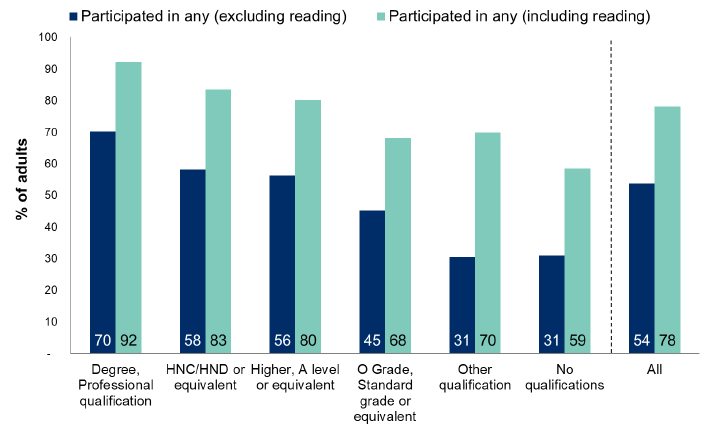
Participation rates for specific cultural activities are shown in Table 12.5.
Table 12.5: Participation in cultural activities in the last 12 months by highest level of qualification
Percentages, 2017 data
| Adults | Degree, Professional qualification | HNC/HND or equivalent | Higher, A level or equivalent | O Grade, Standard grade or equivalent | Other qualification | No qualifications | All |
|---|---|---|---|---|---|---|---|
| Read for pleasure (not newspapers, magazines or comics) | 81 | 71 | 66 | 52 | 61 | 46 | 65 |
| Used a computer / social media to produce creative work of any kind | 39 | 33 | 29 | 23 | 7 | 9 | 27 |
| Crafts such as knitting, wood, pottery, etc. | 23 | 18 | 17 | 13 | 15 | 13 | 17 |
| Dance - e.g. ceilidh, salsa, Highland dancing, ballet | 18 | 12 | 12 | 8 | 4 | 5 | 12 |
| Played a musical instrument or written music | 19 | 15 | 14 | 7 | 2 | 3 | 12 |
| Photography / making films or videos as an artistic activity (not family or holiday 'snaps') | 18 | 15 | 11 | 8 | 3 | 3 | 11 |
| Painting, drawing, printmaking or sculpture | 17 | 14 | 14 | 9 | 4 | 5 | 12 |
| Creative writing - stories, books, plays or poetry | 8 | 6 | 5 | 3 | 1 | 1 | 5 |
| Took part in a play / sang in a choir or other performance (not karaoke) | 7 | 4 | 6 | 3 | 1 | 1 | 5 |
| Other cultural activity | 6 | 4 | 3 | 2 | 1 | 1 | 4 |
| None | 8 | 17 | 20 | 32 | 30 | 41 | 22 |
| Participated in any (excluding reading) | 70 | 58 | 56 | 45 | 31 | 31 | 54 |
| Participated in any (including reading) | 92 | 83 | 80 | 68 | 70 | 59 | 78 |
| Base | 2,880 | 1,080 | 1,510 | 1,770 | 480 | 1,990 | 9,810 |
Columns add to more than 100 per cent since multiple responses allowed.
12.4.3 Participation by Scottish Index of Multiple Deprivation (SIMD 2016)
There was a large difference (24 percentage points) in cultural participation between those living in the 20 per cent most deprived and the 20 per cent least deprived areas (64 per cent compared with 88 per cent). This is consistent with the differences observed for cultural attendance.
Figure 12.10 shows that levels of cultural participation increase as deprivation, as measured by the Scottish Index of Multiple Deprivation (SIMD 2016), decreases. Sixty-four per cent of adults in the 20 per cent most deprived areas participated in cultural activities, compared with 88 per cent of adults in the 20 per cent least deprived areas. When reading is excluded, the pattern is similar, with 41 per cent in the most deprived areas and 63 per cent in the least deprived areas of Scotland participating in a cultural activity.
Figure 12.10: Participation in any cultural activity in the last 12 months by Scottish Index of Multiple Deprivation
2017 data, adults (minimum base: 1,810)
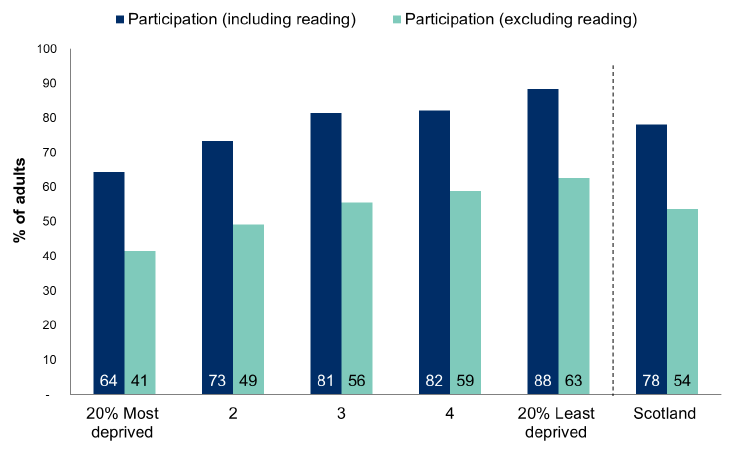
Figure 12.11 shows the difference in cultural participation between the 20 per cent most and least deprived areas and how this has changed over time. This shows that the gap in participation when reading is included has increased since 2012. When reading is excluded, this gap has also increased.
Figure 12.11: Participation in any cultural activity in the last 12 months by area deprivation
2012 - 2017 data, Adults (minimum base: 1,640)
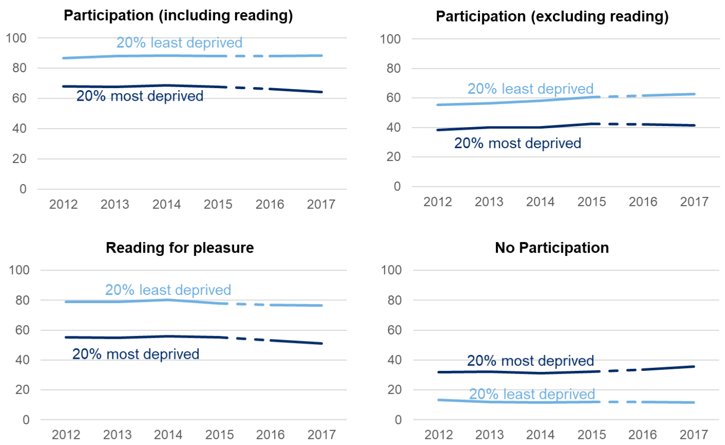
12.4.4 Participation by Long-Term Physical/Mental Health Condition
Figure 12.12 shows that cultural participation was lower for those with a physical or mental health condition (lasting, or expected to last 12 months or more). Participation was lowest where this condition caused long term major reduced daily capacity (65 per cent) compared with 80 per cent participation for those with no such condition. For those with minor reduced daily capacity, the participation rate was 77 per cent.
When reading is excluded, participation for those with conditions with major reduced daily capacity was 38 per cent and, for those with no condition, it was 56 per cent. For those with minor reduced daily capacity, the participation rate was 52 per cent.
Figure 12.12: Participation in any cultural activity in the last 12 months by long term physical/mental health condition
2017 data, adults (minimum base: 1,270)
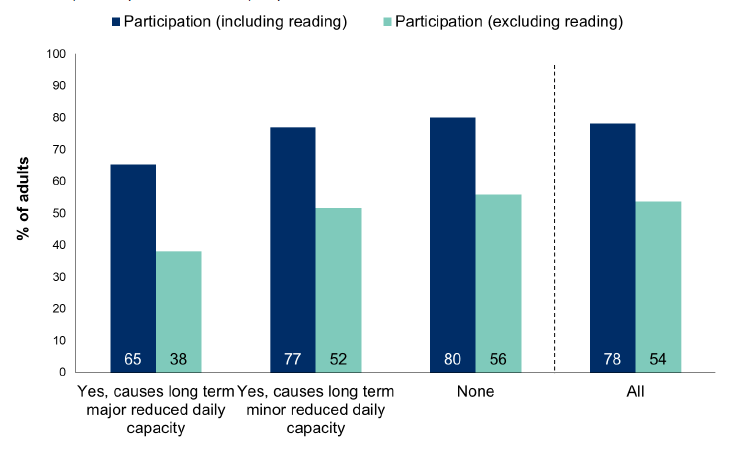
12.4.5 Frequency of Participating in Cultural Activities
Table 12.6 shows that reading for pleasure was the cultural activity most frequently participated in. Of those who read for pleasure, 77 per cent did so at least once a week, and a further 12 per cent read at least once a month. Using a computer or social media for creative work was also popular among participants, with 68 per cent of those who participated having done so at least once a week.
Respondents participated in cultural activities more frequently than they attended cultural places or events. Twenty per cent attended a library at least once a week but, apart from this, attendance at cultural events at least once a week was low. However, participation in cultural activities at least once a week ranged from 25 per cent to 77 per cent.
Table 12.6: Frequency of participating in cultural activities in the last 12 months
Row percentages, 2017 data
| Adults | At least once a week | Less often than once a week / at least once a month | Less often than once a month but within the last 12 months | Don't know | Total | Base |
|---|---|---|---|---|---|---|
| Read for pleasure (not newspapers, magazines or comics) | 77 | 12 | 11 | 0 | 100 | 6,490 |
| Used a computer / social media to produce creative work of any kind | 68 | 13 | 18 | 1 | 100 | 2,380 |
| Crafts such as knitting, wood, pottery, etc. | 48 | 26 | 27 | 0 | 100 | 1,880 |
| Dance - e.g. ceilidh, salsa, Highland dancing, ballet | 25 | 18 | 57 | 1 | 100 | 1,050 |
| Played a musical instrument or written music | 56 | 21 | 23 | 1 | 100 | 1,070 |
| Photography / making films or videos as an artistic activity (not family or holiday 'snaps') | 34 | 33 | 32 | 1 | 100 | 1,090 |
| Painting, drawing, printmaking or sculpture | 40 | 28 | 32 | 0 | 100 | 1,100 |
| Creative writing - stories, books, plays or poetry | 38 | 25 | 37 | 0 | 100 | 460 |
| Took part in a play / sang in a choir or other performance (not karaoke) | 34 | 14 | 51 | 1 | 100 | 410 |
| Other cultural activity | 33 | 21 | 45 | 1 | 100 | 330 |
Columns add to more than 100 per cent since multiple responses allowed.
12.4.6 Reasons for non-participation
Those who reported not participating in any cultural activity in 2017 were asked about potential reasons for non-participation. Overall, the most common reason for not participating was also ‘not really interested’. Over half of non-participants (52 per cent) stated this as a reason (Figure 12.13). This figure has remained stable since 2013 (49 per cent). The next most common reasons were ‘It’s difficult to find the time’ (over a quarter, at 26 per cent), followed by ‘health isn’t good enough’ (14 per cent), and ‘never occurred to me’ (seven per cent).
The main reasons for non-participation varied by age. Lack of interest as a reason for non-participation decreased with age (61 per cent of those aged 16-24 compared to 50 per cent of those aged 75 and older). Poor health as a reason for non-participation increased with age, ranging from 4 per cent of adults aged 16 to 24, to 45 per cent of those aged 75 and older. Lack of time as a reason for non-participation was greater amongst those aged 25 to 34 (41 per cent), compared to those aged 75 and over (5 per cent).
Figure 12.13: Reasons for non-participation in cultural activities in the last 12 months, 2017
Percentage of adults, 2013 and 2017 data (minimum base: 1,940)
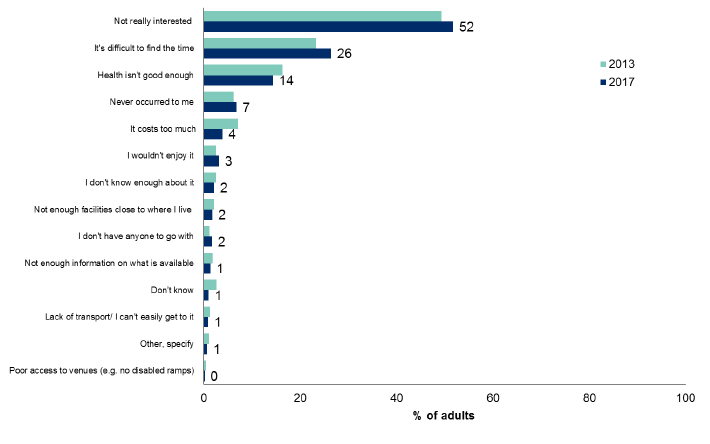
12.5 Satisfaction with Local Authority Cultural Services
Table 12.7 presents the results for satisfaction with three different types of local authority services in 2017. It shows that adults (including users and non-users of these services) were more satisfied with museums and galleries and with theatres or concert halls in 2017 than they had been in 2007. Satisfaction with museums and galleries increased by five percentage points (41 per cent to 46 per cent) between 2007 and 2017 whilst satisfaction with theatres or concert halls increased by three percentage points (44 per cent to 47 per cent). There has been a six percentage point decrease in satisfaction with library services (from 55 per cent in 2007 to 49 per cent in 2017).
Table 12.7: Satisfaction with local authority culture services
Column percentages, 2007 to 2017 data
| Adults | 2007 | 2008 | 2009 | 2010 | 2011 | 2012 | 2013 | 2014 | 2015 | 2016 | 2017 |
|---|---|---|---|---|---|---|---|---|---|---|---|
| Libraries | |||||||||||
| Very/fairly satisfied | 55 | 55 | 53 | 52 | 52 | 50 | 51 | 49 | 49 | 48 | 49 |
| Neither satisfied or dissatisfied | 10 | 8 | 7 | 8 | 8 | 8 | 10 | 12 | 15 | 15 | 17 |
| Very/fairly dissatisfied | 3 | 2 | 2 | 3 | 2 | 2 | 2 | 2 | 2 | 2 | 2 |
| No opinion | 32 | 34 | 37 | 38 | 37 | 39 | 38 | 36 | 34 | 35 | 32 |
| Museums and galleries | |||||||||||
| Very/fairly satisfied | 41 | 42 | 41 | 38 | 44 | 42 | 44 | 46 | 46 | 45 | 46 |
| Neither satisfied or dissatisfied | 14 | 12 | 10 | 11 | 10 | 10 | 11 | 14 | 16 | 17 | 18 |
| Very/fairly dissatisfied | 4 | 3 | 3 | 2 | 2 | 2 | 2 | 2 | 2 | 2 | 2 |
| No opinion | 41 | 42 | 45 | 48 | 44 | 46 | 42 | 38 | 35 | 36 | 34 |
| Theatres or concert halls | |||||||||||
| Very/fairly satisfied | 44 | 44 | 43 | 42 | 45 | 44 | 46 | 47 | 48 | 47 | 47 |
| Neither satisfied or dissatisfied | 14 | 11 | 10 | 10 | 10 | 9 | 10 | 13 | 15 | 16 | 17 |
| Very/fairly dissatisfied | 5 | 4 | 4 | 3 | 3 | 2 | 2 | 2 | 3 | 2 | 2 |
| No opinion | 38 | 40 | 43 | 45 | 42 | 45 | 42 | 38 | 35 | 35 | 34 |
| Base | 10,220 | 9,240 | 9,710 | 9,020 | 9,660 | 9,890 | 9,920 | 9,800 | 9,410 | 9,640 | 9,810 |
Table 12.8 shows levels of satisfaction with local authority provision is considerably higher when only users of the services are included in the analysis. In 2017, around nine in ten adults were either very or fairly satisfied with each of the three services (between 87 per cent and 91 per cent). As noted above, the overall level of satisfaction with library services has decreased since 2007, with satisfaction levels among non-users driving the decrease. In contrast, the levels of satisfaction among the service users have increased or remained stable since 2007 across all services.
Table 12.8: Satisfaction with local authority culture services. (Service users within the past 12 months only)
Column percentages, 2007 to 2017 data
| Adults | 2007 | 2008 | 2009 | 2010 | 2011 | 2012 | 2013 | 2014 | 2015 | 2016 | 2017 |
|---|---|---|---|---|---|---|---|---|---|---|---|
| Libraries | |||||||||||
| Very/fairly satisfied | 90 | 92 | 92 | 91 | 92 | 93 | 92 | 92 | 92 | 93 | 91 |
| Neither satisfied or dissatisfied | 5 | 4 | 4 | 4 | 4 | 3 | 3 | 4 | 4 | 4 | 5 |
| Very/fairly dissatisfied | 3 | 3 | 3 | 4 | 2 | 2 | 3 | 2 | 3 | 2 | 2 |
| No opinion | 2 | 1 | 1 | 2 | 2 | 2 | 2 | 2 | 1 | 1 | 2 |
| Base | 4,090 | 3,510 | 3,590 | 3,400 | 3,510 | 3,450 | 3,370 | 3,270 | 3,100 | 3,060 | 3,160 |
| Museums and galleries | |||||||||||
| Very/fairly satisfied | 87 | 89 | 88 | 87 | 90 | 92 | 91 | 92 | 91 | 91 | 87 |
| Neither satisfied or dissatisfied | 8 | 7 | 6 | 7 | 5 | 3 | 4 | 5 | 6 | 5 | 8 |
| Very/fairly dissatisfied | 2 | 2 | 3 | 2 | 1 | 2 | 2 | 1 | 2 | 1 | 2 |
| No opinion | 3 | 2 | 4 | 4 | 4 | 3 | 3 | 2 | 2 | 3 | 3 |
| Base | 2,870 | 2,630 | 2,720 | 2,460 | 2,830 | 2,800 | 2,980 | 3,020 | 2,920 | 2,830 | 2,990 |
| Theatres or concert halls | |||||||||||
| Very/fairly satisfied | 86 | 87 | 88 | 88 | 89 | 90 | 91 | 91 | 90 | 90 | 89 |
| Neither satisfied or dissatisfied | 8 | 6 | 6 | 6 | 5 | 5 | 4 | 5 | 6 | 6 | 7 |
| Very/fairly dissatisfied | 3 | 4 | 3 | 3 | 3 | 2 | 2 | 2 | 2 | 2 | 1 |
| No opinion | 3 | 3 | 3 | 3 | 3 | 3 | 3 | 3 | 3 | 3 | 3 |
| Base | 3,560 | 3,210 | 3,270 | 2,960 | 3,280 | 3,020 | 3,260 | 3,290 | 3,340 | 3,230 | 3,270 |
Contact
There is a problem
Thanks for your feedback